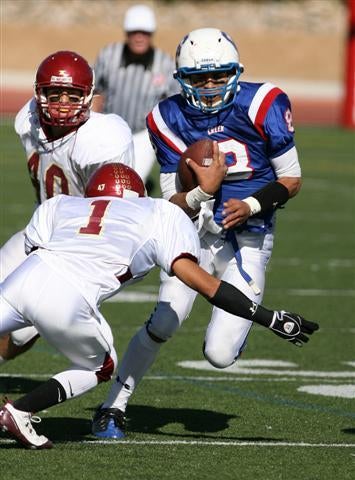No team has made a bigger splash on the recruiting trail in recent weeks than Stanford.
With word that Hamilton (Chandler, Ariz.) star defensive back Devon Harrington committed to the Cardinal, the number of verbal commitments for the class of 2010 rose to an astounding 21. Stanford now has more commitments than any school in the country.

Kain Colter will be heading west next fall.
Photo by Patrick Miller
Jim Harbaugh has done an excellent job reeling in recruits from across the nation. The 2010 class has commitments from players residing in more than a dozen different states, including Gainesville (Ga.) athlete Tai-ler Jones, Good Counsel (Olney, Md.) defensive back Louis Young and Kain Colter, a quarterback from Colorado.
The momentum has carried into the class of 2011, as well. After a strong performance at a Stanford camp last week, rising junior running back Amir Carlisle also jumped on the Harbaugh bandwagon. Carlisle scored 15 touchdowns last season for The Kings Academy (Sunnyvale, Calif.) while rushing for nearly 1,000 yards. Battling injury, Carlisle played in only seven games, but rushed for more than 200 yards on two separate occasions.
At the time of his commitment, Carlisle was the youngest recruit to ever commit to Stanford. He held that title for less than 24 hours. That’s because 2012 recruit Skyler Mornhinweg pledged to be a Cardinal the very next day.
Mornhinweg is the son of Marty Mornhinweg, who served as the 49ers offensive coordinator from 1997-2000. His familiarity with Stanford after living in the Bay Area no doubt helped with his decision. He started at safety for St. Joseph’s Prep, a top Philadelphia program. At 6-foot-3, he is being recruited by Stanford to play quarterback. However, it’s still unclear if Mornhinweg will win the job for the Hawks this fall.
The commitments of Carrington, Carlisle and Mornhinweg demonstrate Harbaugh’s aggressive recruiting strategy. Traditionally, Stanford has waited to make sure athletes could meet the school's rigorous entrance requirements, but Harbaugh has turned the tables, targeting players at an earlier age to get a jump on Pac-10 foes.
He intends to weed out those who don't cut it academically down the road. This has allowed Stanford to build name recognition and get valuable exposure in an effort to beat traditional recruiting powers to the proverbial punch.
However, there are several potential pitfalls to soliciting and accepting such early commitments. First, it can be hard to project how a player will develop after only his freshman or sophomore season. For some positions more than others, it can be hard anticipating growth and maturation two or three years into the future.
Another challenge Stanford and other schools could potentially face is players decommitting from their verbal pledges. While this is not particularly uncommon, it could become problematic if schools secure early commitments and no longer recruit players at those positions. In this case, decommitments late in the recruiting season could be crippling.
Tony Jefferson backed out of his commitment to the Cardinal in January after committing in September. His stock has since skyrocketed and Stanford appears to be out of the picture. In the case of Jefferson, Stanford has plenty of time to address that need. Carrington will help.
South Carolina Targeting More Freshmen
Another school wasting no time getting acclimated with top rising stars is South Carolina. Head coach Steve Spurrier and his staff have been aggressive in pursuing players at an increasingly young age.
Last season, the Gamecocks issued verbal offers to Myrtle Beach quarterback Everett Golson and Charon Peake, a wide receive from Dorman. Both were sophomores last season, and will be two of the top juniors in the Carolinas in 2009.{VIDEO_6dd9182f-2371-4460-9c7b-56f9adbc4e85,floatRightWithBar}
This year, Spurrier has broadened his outreach, and has set his sights on a number of top recruits in the Southeast. Shaq Roland, a quarterback/defensive back from Lexington (Ky.), already has an offer. So does Flowery Branch (Ga.) running back Imani Cross. Both are freshmen and locks to be make the cut for the MaxPreps Fresh Faces Top 100, set to debut in July.
Though it’s early, Cross is favoring South Carolina. The word on Cross is that he’s an extremely powerful back that can stand to improve his quickness. If he does that, there’s no reason he shouldn’t blossom into a huge recruit by the time he’s a senior.
Vols Pick Another Berry
Football recruiting took an even more drastic turn toward younger athletes when 13-year-old Evan Berry, the brother of Tennessee star safety Eric Berry, accepted a verbal scholarship offer from Lane Kiffin, despite not having played a down of high school football yet.
Kiffin is rolling the dice that the 145-pound Evan Berry will develop the same way his brother and father did. James Berry, Eric and Evan's father, is a former running back for the Vols. This should be an interesting case study.
Unlike basketball, where top players are often identified before entering high school and play against each other in summer camps and AAU showcases, football offers no such barometer for evaluations.
Given the extremely physical nature of the sport and the importance of the maturation that occurs during high school years, it’s very hard to look four years into the future and predict if a player will be equipped body-wise to handle the rigors of Division I college football.
